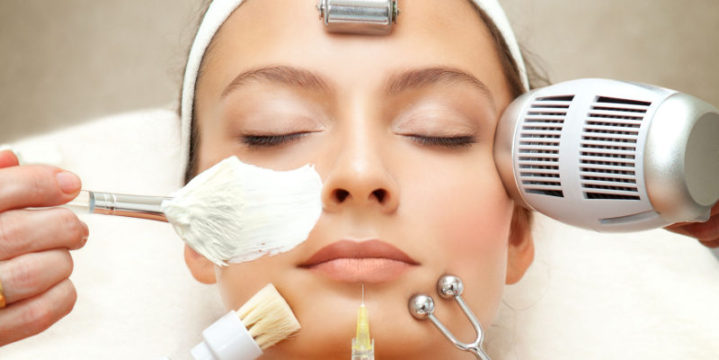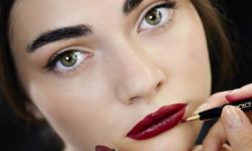
Tighten Up!
Technology and skincare have collided more than ever before and Dr. Kate Jameson, Cosmetic Physician and the Medical Director of Youth Lab, Australia’s premier medical aesthetics clinic, has everything you need to know about skin tightening.
What causes sagging skin?
One of the hallmark signs of ageing skin is a loss of skin elasticity and laxity which presents to many as “sagging skin”.
With age, the skin itself changes with a loss of collagen and support as well as a loss of elastin. Elastin provides the skin with the ability to stretch and snap back into position when elastin is lost the skin becomes loose and slack and is unable to maintain its structure and position. This can all result in skin that is thinner, looser and sagging.
Although many of these changes eventually occur in everyone. The changes to skin quality, especially the quality and amount of elastin and collagen, are significantly affected by the environment. Factors such as long term UV exposure and smoking are the main culprits. Other causes include air pollution, poor nutrition, and rapid, extensive weight loss (and also weight fluctuations over time).
One of the major causes of skin sagging, smoking, causes a loss of elastin and collagen by the production of free radicals. This is when once-healthy oxygen molecules become overactive and unstable. Free radicals damage cells, leading to, among other things, premature wrinkles and sagging.
Skin damaged by the environment appears course, roughened and is deeply wrinkled with a loss of elasticity and recoil, making the skin appear “saggy”
Skin sagging generally becomes more apparent as the effects of environmental and lifestyle changes appear, usually in the 40-50s, especially for women. These environmental factors can worsen and accelerate wrinkling and sagging of the skin.
What treatments work best for neck and jowls?
The area that bothers most people when their skin begins to lose elasticity and start to sag is the lower face (and jowls) as well as the neck.
The majority of the treatments that work best for this area utilise methods of inducing collagen and elastin production by triggering a cascade of events within the skin that stimulates cell formation through controlled inflammation and wound response. With increased production of collagen and elastin comes skin that thickens and becomes firmer, reducing the appearance of sagging jowls and neck bands.
With these treatments results are subtle and cumulative, it can take many months for collagen stimulation to become evident but long term results are impressive and will continue to improve.
Radio Frequency is a popular method which works to deliver heat energy into the skin to remove damaged collagen and stimulate a wound response in the skin, which over time then produces a skin tightening effect that peaks over a 3 to 6 month period. Radiofrequency Skin tightening synthesizes new collagen to thicken and add extra support to the skin. There are multiple options available such as older monopolar radiofrequency treatments such as Thermage and Pelleve and newer bipolar Radiofrequency treatments which often combine micro-needling to further enhance the effects such as the Intensif and Infini. A series of these treatments is always recommended, often 4-6 weeks apart with results evident even at 12 months. Treatment is generally comfortable with minimal downtime.
Ultrasound is gaining popularity as a skin tightening treatment with treatments such as Ultherapy and Ulthera. Ultrasound works by delivering intensely focused ultrasound energy into the skin as thermal energy to the deep dermis and subcutaneous layers. As with radiofrequency, zones of heat are produced within the highly focused beam from the absorption of the energy into the tissue. Ultrasound has the benefit of penetrating very deep and can result in the deep tightening of the SMAS layers of the face, giving a lifting effect. Almost like a non-surgical lower facelift to the jowls in some people.
What treatment is best for tightening your face after weight loss?
One of the main contributing factors to sagging skin is rapid weight loss or fluctuating weight over time. With weight loss, the fat pads in the face start to atrophy (that is they become smaller) which means there is less support for the skin which overlies it. Combined with the ageing process where fat in the face is lost naturally, weight loss can compound the effects and result in a gaunt appearance with sagging skin overlying. The best treatment is prevention and to always avoid rapid weight changes and maintain a healthy weight with regular physical activity and a healthy, balanced diet. For those who feel their skin has thinned and is sagging following a period of weight loss, there are non-surgical options.
The key with treatment is replacing the lost volume and restoring the natural facial contours to support the skin. One of the best treatment options for this is Collagen Stimulating or Bio-stimulating dermal fillers. These products are injected into the deeper layers of the skin and work over 3 months to stimulate collagen to both revolumise the tissue and thicken the skin to reduce sagging. These fillers give a natural result without looking “overfilled” and essentially restore what was once there.
Laser is another popular non-surgical option for skin tightening of the face. Laser uses directed laser energy to result in coagulation and ablation of the tissues which again, stimulates a controlled wound response and the production of new, healthy collagen. The more heat that is delivered precisely into the skin, the more of a tightening effect will be evident. Ablative lasers such as CO2 and Erbium are generally more effective for skin tightening as they ablate the epidermis causing a contraction of the tissues but they are associated with higher risk and downtime than non-ablative lasers. Regular laser treatments, when performed in skilled hands, can be an excellent maintenance and preventative option to ensure healthy collagen and elastin within the skin
Other popular treatment options to prevent skin sagging and improve facial skin following weight loss include microneedling which uses physical needles to stimulate a controlled wound response in the skin, again working to stimulate collagen. Platelet Rich Plasma or PRP is another option which works as a natural treatment, utilising the body’s own plasma to regenerate the skin and repair damaged collagen and elastin fibres. Overall these treatments can work to maintain and restore the integrity of the skin following weight changes, as well as prevent further changes over time.
Unfortunately, dermal fillers and non-surgical skin treatments can not be used to “lift” the skin per se and those who have significant facial sagging will need a surgical facelift.
What preventative treatments work well to combat sagging skin from aging?
The primary prevention method to combat skin sagging from ageing is to avoid exposure to UV radiation. Prevention is better than cure. Preventative strategies include the daily use of a broad spectrum SPF 50, the use of protective measures such as a hat as well as avoidance of the sun in peak times and using shade as much as possible. It goes without saying that sun tanning and the use of sunbeds should be avoided.
Smoking is another contributor and smoking cessation and avoidance of passive smoking is essential to maintain healthy skin and prevent further free radical damage. The avoidance of air pollution is important and this can vary significantly depending on where in the world you live.
Using antioxidants in skincare is especially helpful to protect the skin from damaging free radicals. Antioxidants such as vitamin C (or L-Ascorbic Acid) are essential for collagen synthesis and are a powerful antioxidant for free radical scavenging, protecting from the effects of UV radiation and environmental stressors. As a result, they can be used as a preventative method for skin sagging due to the impact oxidative stress has on elastin and collagen within the skin.
Other preventative strategies to prevent skin sagging in healthy skin include maintaining a healthy diet filled with healthy fats and protein, regular exercise and maintaining a healthy weight (eg no rapid weight fluctuations or rapid weight loss). Hormonal treatments may also come in to play especially for women as early menopause can contribute to a loss of collagen.
The use of topical at-home skincare and in-clinic treatments can also be utilised while the skin is still healthy, to avoid sagging and maintain skin integrity and firmness. Using in-clinic treatments regularly such as skin needling, laser resurfacing, radiofrequency and the appropriate use of injectables will maintain the skin quality and prevent significant sagging.

Thread Lifts
What is a thread lift?
A Thread Lift is a non-surgical facelift using fine sutures to lift and volumize the face and neck without the downtime and invasiveness of a surgical procedure. It is also a suitable alternative to those who do not wish to have cosmetic injectables.
In a Thread Lift, small anchoring sutures are inserted in specifically determined areas of the face and are then used to elevate and lift the sagging areas providing immediate results. Rejuvenating threads are also used to improve the condition of the skin and treat superficial imperfections such as textural irregularities and fine lines.
As we age we lose facial volume through bone resorption, muscle atrophy, fat loss and redistribution resulting in noticeable changes in the overlying skin with sagging, loss of skin tone and contour irregularities. Combined with the gradual loss of collagen and elastin, the skin becomes looser and begins to sag which further contributes to a tired and aging face.
Thread lifts can target these changes by providing structural support and lift through the biodegradable sutures which are long-lasting with a slow breakdown rate in the skin. Threads also actively work to stimulate collagen production which, over time, works to increase the volume and restore the shape of the face naturally.
What are the different types of threads available?
There are multiple types of threads available for Doctors to use however these all use a fine synthetic material which is designed to dissolve over time. These materials all have a long history of safe and reliable use in medicine and surgery such as in sutures to close wounds. This material will dissolve over time and is eliminated from the body.
The types of threads can be classified as lifting or rejuvenating threads.
Lifting threads work to treat mild to moderate skin laxity by providing mechanical support and physically lifting sagging tissues.
Rejuvenating threads (called Mono threads) work to rejuvenate the skin by tightening and reconditioning. They can work to improve the appearance of fine lines, wrinkles and skin texture by stimulating collagen.
How do I know which type is best for me?
Threads now offer a non-surgical alternative to injectables which have the potential to improve the condition of the skin and treat skin laxity. The treatment objective depends on the type of thread being used.
Those who need a full facial treatment offering contouring, lifting of the lower face and reducing jowls as well as improving the appearance of a sagging neck will benefit from lifting threads.
Rejuvenating threads offer a more subtle result and can be used to stimulate collagen and reduce the appearance of fine lines like lip lines as well as offering generalised skin tightening and reconditioning across the entire face
A good candidate for a thread lift has healthy skin and is a non-smoker. Those with significant skin sagging and thin, lax skin will not be a suitable candidate for a thread lift and may need surgical treatment.
For more, visit youthlab.com.au





